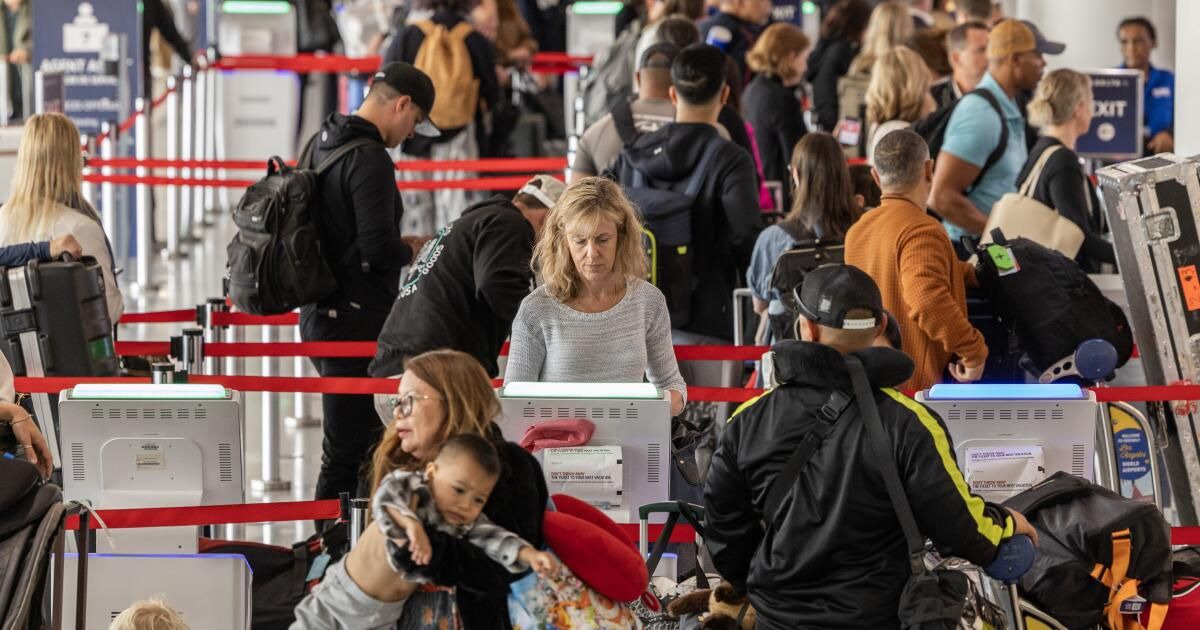California may be headed for an earlier-than-normal start to the summer COVID-19 season, with coronavirus concentrations in wastewater rising in some areas along with the rate of positive tests statewide. .
The trend comes as the latest family of coronavirus subvariants, collectively called FLiRT, has made significant progress nationwide.
The FLiRT subvariants, officially known as KP.2, KP.3 and KP.1.1, have overtaken the dominant winter strain, JN.1. For the two-week period beginning May 12, they were estimated to account for a combined 50.4% of the country's coronavirus infections, up from 20% the previous month.
Rather than California seeing a reduction in COVID-19 circulation, as it did earlier this spring, state health officials said they estimate the spread is now stable or slowly increasing.
“COVID-19 concentrations in wastewater have suggested increases in several regions of California since early May. COVID-19 test positivity has been slowly increasing since May,” the state Department of Public Health said in a statement to the Times on Friday.
During the seven-day period ending Monday, about 3.8% of COVID-19 tests came back positive; at the end of April, that proportion was 1.9%. (Last summer's peak positive test rate was 12.8%, in late August.)
Doctors at hospitals in Southern California and the San Francisco Bay area are also seeing an increase in the spread of the coronavirus.
“We are certainly seeing a small increase. And this is all due to the so-called FLiRT variants,” said Dr. Elizabeth Hudson, regional chief of infectious diseases at Kaiser Permanente in Southern California.
So far, the increase has been seen primarily in outpatient cases at Kaiser.
“Every time there is a new variant, unfortunately, the new variants will have the ability to [overcome immunity resulting from prior infection]”And if it's been a while since someone was vaccinated, they obviously won't have the same level of protection as someone who was vaccinated more recently,” Hudson said.
In San Francisco, infectious disease doctors are noticing more people in the hospital with pneumonia caused by COVID.
“I've seen more people sick than I expected in the hospital” from COVID, said Dr. Peter Chin-Hong, an infectious disease expert at the University of California, San Francisco. The number was only a handful, “but it definitely shows.”
Based on his reading of the wastewater data, “we know it has increased and it has increased before,” Chin-Hong said of coronavirus activity.
“Last year, I think it was the end of June when it started to rise, and this year it's like the end of May. So it's a little early, but we're starting from a very low place,” Chin-Hong said.
And anecdotally, it seems like people in the Bay Area are talking more about COVID, Chin-Hong said. She recalled hearing about a COVID case in a son's classroom a few days ago.
“It's not necessarily an alarming number now, but it's … early summer, so that's what we expect,” Chin-Hong said.
The Los Angeles County Department of Public Health has also begun to see a very small increase in cases in recent days.
From May 10 to 15, the most recent data available, there were an average of 82 to 92 cases of COVID-19 per day, an increase from early spring. There were an average of 60 to 80 new cases per day between March 25 and May 9, Los Angeles County health officials said in a statement to the Times. Case counts generally reflect tests performed in medical facilities and do not include home tests, nor do the counts represent infections among people who do not get tested.
“It is too early to say whether this small increase in recent days will become a sustained rally. These case counts are low, making it difficult at this time to assess actual trends,” the Los Angeles County Department of Public Health said.
Coronavirus levels in Los Angeles County wastewater remain relatively stable, at 9% of last winter's peak. But data for those findings has a significant reporting lag: The most recent data available is for the 10-day period ending May 11.
In other parts of the state, viral levels in wastewater are rising, including Santa Clara County, the most populous in Northern California and home to Silicon Valley. In recent weeks, coronavirus levels have reached the “high” threshold in Palo Alto sewers.
With the summer travel season set to begin in earnest this Memorial Day weekend, doctors urged people to consider updating their vaccines, especially if they are at higher risk for serious complications from COVID-19.
In California, only 36% of people over 65 have received the updated COVID-19 vaccine that first became available in September. The U.S. Centers for Disease Control and Prevention has urged everyone over 6 months old to receive a dose of the updated vaccine. A second dose is also recommended for people 65 years and older, as long as at least four months have passed since the last injection.
It is especially important that older people receive at least one updated dose. Of the patients he has seen recently who had severe COVID, Chin-Hong said, all had not received an updated vaccine since September and were generally 75 years or older or immunocompromised.
“We are still seeing people hospitalized and, according to CDC data presented in February, more than 95% of those hospitalized had not received the updated 2023-2024 vaccine,” the Los Angeles County Department of Public Health said. CDC data has shown that receiving the updated vaccine offered 54% more protection against COVID-19 disease compared to those who did not receive the vaccine.
For seniors now considering a second updated COVID-19 vaccine, factors to consider include travel plans or whether they have a job where they interact with many people, doctors say. There is plenty of time to receive that vaccine now and also to receive the new formulation expected in the fall.
“By getting your booster now, you will really protect yourself to get through this likely summer wave,” Hudson said.
Although for many people COVID no longer means a hospital visit, “for some people it is a big deal,” Chin-Hong said. “And those are the people I saw in the hospital: they were very, very sick and they were there for some time.”
Nationally, since the beginning of October, more than 43,000 people have died from COVID, according to the CDC, including more than 3,400 in California. By contrast, the flu has probably caused fewer deaths nationally: about 25,000 over the same period.
The risk of death among those hospitalized is higher for those with COVID than the flu, especially among older people, according to the Los Angeles County Department of Public Health.
“When you're in the hospital, a lot of other things can happen. …You can get hospital-acquired infections. That is why hospitalization should always be avoided,” said Chin-Hong.
California recently achieved a major COVID milestone: zero deaths on a single calendar day, April 2, a feat that had not been accomplished since the early days of the pandemic. Los Angeles County also experienced a new all-time low for deaths: an average of 0.14 deaths per day over a weekly period, which was recorded during the seven-day period ending April 2.
“It is truly a triumph of science that we have reached a point where we have a day where there will be no deaths from COVID,” Hudson said, crediting factors such as the development of anti-COVID vaccines and drugs, as well as of improvement. Techniques used to treat patients.
Still, “COVID is not just a flu or a cold,” Hudson said. “For some people, COVID can potentially have very long-lasting impacts. … Long COVID really makes things different.”
There is growing evidence that the more times you get COVID, the more likely you are to develop it for a long time, Hudson said. And “it appears that people in their 30s and 40s are the most likely to have long COVID.”
Some patients have been permanently disabled by long COVID, but, Hudson said, “for most people, it seems, maybe after 12 months, sometimes 18 months, that all the symptoms resolve. But it's a long time to not feel good.”
There has been much discussion that the long-term prevalence of COVID is lower than at the beginning of the pandemic. But even now, whenever someone gets COVID, there is still a chance that they will develop COVID for a long time.
Some patients “have trouble breathing,” Hudson said. Others may develop something called POTS, which stands for postural orthostatic tachycardia syndrome, and can cause sharp spikes in heart rate and dizziness.
“Long COVID can affect the autonomic nervous system in ways we don't 100% understand yet,” Hudson said. “But we know that people end up with this particular syndrome and it can be life-altering.”
In addition to getting up to speed on vaccinations, doctors offered the following advice on how to prepare for an expected surge in COVID circulation:
• Avoid sick people. Some sick people may pass off their symptoms as a “cold,” when it could be the beginning of COVID-19 illness.
• Test yourself if you are sick and do it daily. Sometimes after the onset of illness, a rapid COVID-19 test takes longer to come back positive. Consider performing a rapid COVID test once a day for three to five consecutive days after the onset of cough and cold symptoms, Hudson recommended. Doing so can help the sick person take steps to later isolate themselves and limit the spread of the illness to others.
• Have a plan to order Paxlovid if you get sick. Paxlovid is an antiviral medication that, when taken by people at risk for severe COVID-19 who have mild to moderate illness, reduces the risk of hospitalization and death.
• Masks are much less common today, but they can still be a useful tool in preventing infection. Wearing a mask on a crowded flight where people are coughing nearby can help reduce the risk of infection.












